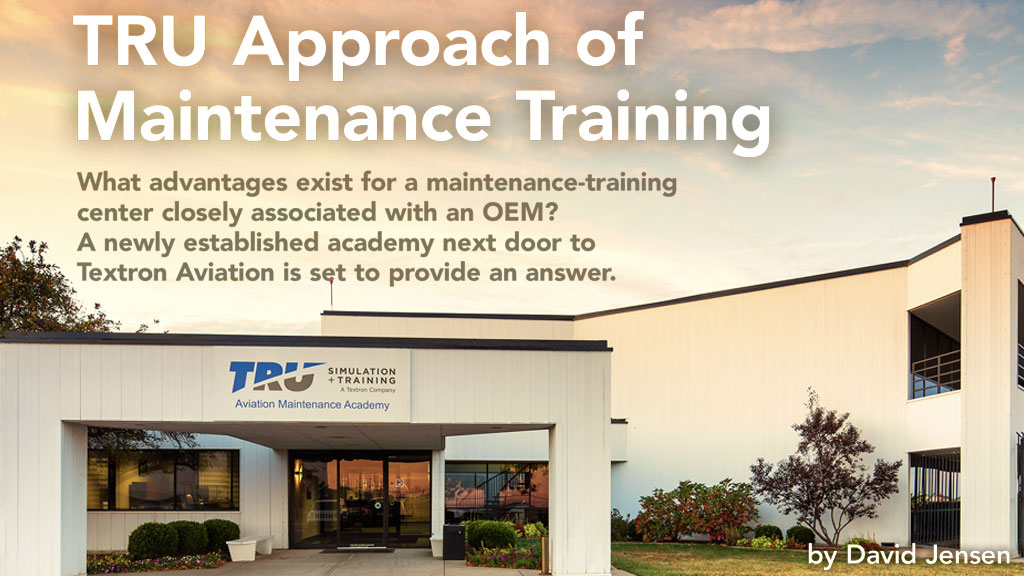What advantages exist for a maintenance-training center closely associated with an OEM? A newly established academy next door to Textron Aviation is set to provide an answer.
Textron Inc.’s full-on entry into the aviation-training field begat a unique center for maintenance instruction accredited by OEMs. Unique because the center’s location in Wichita, Kan., allows it unlimited access to the aircraft, systems data and engineering expertise on hand at the OEM it primarily serves: Textron Aviation. Unique, too, because of the center’s depth of training, especially in creating a real-world experience.
The TRU Aircraft Maintenance Academy (TAMA), which opened in late 2015, is located on the premises of Textron Aviation’s headquarters and the plants where Cessna and Beechcraft airplanes are assembled. It established an incremental growth plan that began with maintenance training for the Beechcraft King Air airplane family and products produced by McCauley Propeller Systems, a Cessna subsidiary purchased in 1960. A small part of TAMA’s business also includes OEM-certified training to maintain Beech and Cessna piston-powered aircraft: Baron, Bonanza, 172, 182, and 206 models.
But that is only a start. TAMA now offers maintenance training courses for all Cessna airplanes in production as well as legacy aircraft built by Cessna and Beechcraft. Most recently, the academy received approval from EASA for several popular Cessna and Beechcraft theory and practical courses for the King Air 200, 208 Caravan, 560 Excel, and 680 Sovereign/Latitude.
“We’re talking about a seven- or eight-fold increase in product [training program] offerings,” say David Smith, TRU’s vice president, training centers. “Ultimately, we plan to offer maintenance training for Hawker jets, too, but that’s long term.” In addition, TAMA officials are pursuing maintenance training for all aviation products—engines, avionics, landing gear, hydraulic systems, etc.—that OEMs may choose not to provide themselves.
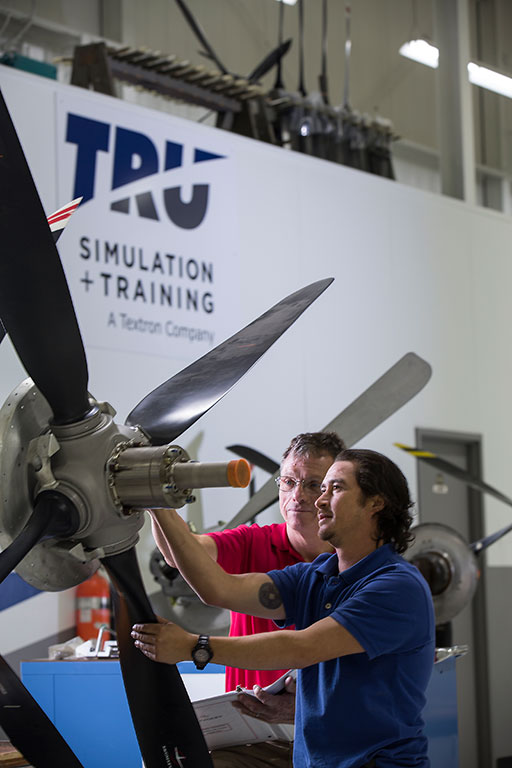
Foray into Training
TAMA’s plans are all part of Textron Inc.’s goal in becoming an aviation-training powerhouse. Smith attributes the corporate parent’s intent, in part, to the fact that “several members” of Textron’s Leadership Team, including chairman and CEO Scott Donnelly, are pilots with years of aviation experience. In addition, he adds, Textron leadership “determined that Textron product customers can come to us for literally everything: devices, aircraft and training for both pilots and maintenance technicians.”
“Before we established our own training services, we had partnerships with training outfits around the world,” he says. “FlightSafety was probably our biggest partner.”
James Hall, dean of Aviation Technologies at Wichita Area Technical College, which offers ab-initio maintenance training and is located across town from TAMA, proposes another take on why Textron launch its training business. “FlightSafety International offers some 90 percent of the aircraft-specific training for general aviation,” he says. “Textron saw an opportunity to bring training in-house and have tighter control.”
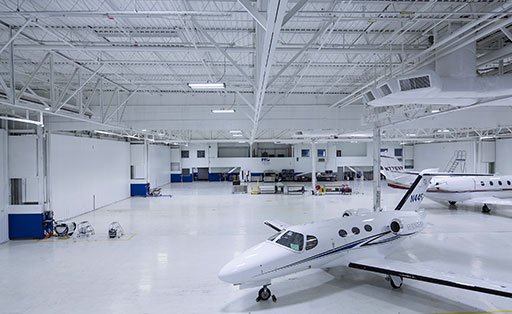
Textron’s plan to go its own way in training began in earnest after the acquisition in November 2013 of Montreal-based Mechtronix and Florida-based Opinicus Corp., both manufacturers and supporters of aviation simulators. These two companies were joined with AAI Corp., acquired by Textron in 2007, to form TRU Simulation + Training Inc., headquartered in Goose Creak, S.C. (TRU is not in itself an acronym, but the company’s full name was chosen, in part, to create the acronymic word “TRUST.”) Early in 2017, TRU completed another acquisition: ETOPS, a training and simulation services provider with offices in France and Malaysia. This expansion boosted the company’s management and staff to about 1,000 employees.
As is evident in its name, TRU Simulation + Training comprises two profit centers. The company began solely as a designer and producer of training devices, including full flight simulators for business and commercial aviation. Boeing, for example, has contracted TRU to supply flight simulators for both the B777X and B737 Max. Not surprisingly, TRU’s simulator branch takes on capital projects, supplying devices for the company’s other profit center: training. For example, TRU’s pilot training programs utilize company-built simulators.
TRU also furnishes maintenance-training equipment to military customers on a system or subsystem level. Examples include devices to simulate failure modes in landing gear, electrical systems and doors for aircraft such as the C-130, C-17, F-22 and F-35.
TRU has two pilot training centers for business aviation, in Tampa, Fla., and Carlsbad, Calif. In addition, the Textron subsidiary provides on-site pilot training services to foreign militaries, for example, serving operators of the Beech T6 trainer/attack aircraft.
“At the same time we started pilot training, we began a land deal at Textron Aviation to establish a Part 147 maintenance training academy,” says Smith, referring to the TAMA center. However, TRU’s maintenance training is not confined to its Wichita facility. Beyond U.S. borders, the company provides both pilot and maintenance-technician training through “high-level partnerships,” according to TRU vice president. In February of 2017, TRU and sister-company Bell Helicopter teamed up to open their first international pilot training center, located in Valencia, Spain. Here, they provide regional rotorcraft pilots with initial type rating and recurrent training on their innovative ODYSSEY H simulator, beginning with pilot training for the Bell 429.
Non-U.S. facilities under Textron’s purview are significant to TAMA’s mission because they provide venues to conduct maintenance instruction around the world. Such services are particularly beneficial for customers regulated by the European Aviation Safety Agency (EASA), which has more, if not the most, stringent maintenance-training requirements.
Often a Textron service center will request TAMA’s service at its location; however, invitations to provide on-site training also may come from Textron Aviation aircraft operators and third-party service centers that maintain and/or modify the OEM’s aircraft. TAMA’s requirement is that classes outside of Wichita take in at least four students each. TAMA currently conducts about 20 to 30 on-site training sessions a year, but more are expected as the academy’s curricula grows to include more aircraft families.
TAMA has made their maintenance instruction quite portable. For its “robust” courseware (visual aids), “we just need connectors to our monitors,” says Smith. Because of its off-site capability, TAMA management “currently has no intention of opening another facility like this one,” he adds, referring to the Wichita academy.
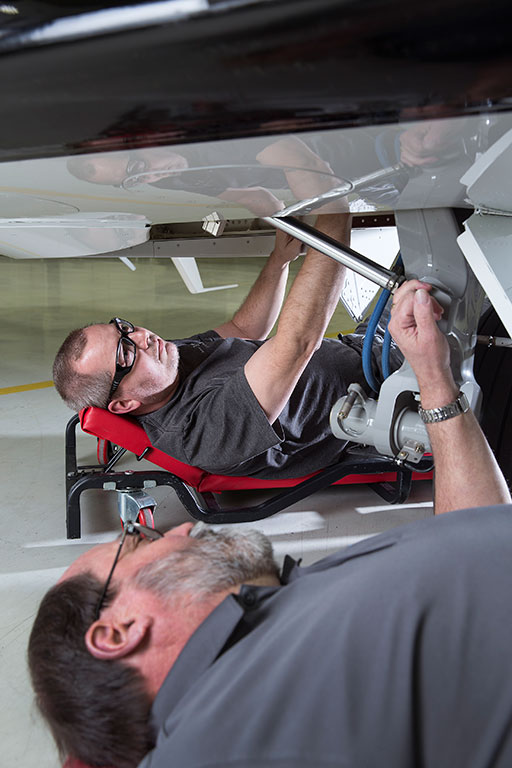
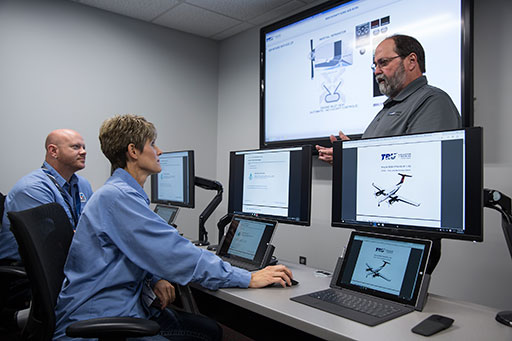
(Textron image)
Training in Wichita
TRU is an autonomous Textron subsidiary, which means it must compete for contracts, even from Textron Aviation. “We have to demonstrate our value,” says Smith. He adds that TAMA won the King Air maintenance-training program, in part, because of fortuitous timing. The King Air 350i/ER with Pro Line Fusion avionics happened to enter the market about the same time TAMA opened its doors, and Textron Aviation needed a maintenance-training program to accompany the new aircraft.
For hands-on, or practical, training, TAMA has a King Air fuselage in the hangar section of its modern 35,000-square-foot, climate-controlled facility, once Textron Aviation’s customer center, where Cessna buyers took delivery of their aircraft. For authenticity during hands-on training, TAMA instructors make sure the King Air needs repair, according to Smith. A tool crib is on hand with more than 600 parts, some used and some new from Textron Aviation. Maintenance equipment not available in TAMA’s hangar can be accessed at one of Textron Aviation’s nearby facilities. Near the King Air, a large LCD screen shows a manual with tasks to perform—in fact, tasks students from EASA-controlled countries must perform in order to satisfy the European agency’s Part 145 rules.
In a corner of the hangar away from the King Air, TAMA conducts hands-on maintenance training for the McCauley propellers. About a half dozen holding stands bear propellers that, during a five-day class, are completely disassembled down to the hub and then reassembled according to the McCauley maintenance manual. “Students will do that three times,” says Rodney Dowell, TAMA’s center manager. “The third time, they receive no assistance, so we make sure they fully understand how to repair the propellers.”
TAMA’s staff assures the propellers need repair. “Students will have to do things like balance the blades, file dings out and put in new O-rings,” says Dowell. All needed tools and parts
are available.
Classroom Instruction
Adjoining TAMA’s hangar is a modern complex of offices, a reception area, five classrooms and a sixth classroom is currently under construction and set to be open by mid-Q1 of 2018.
TAMA does plan to add to its instructor staff, however, from eight to about 10 in preparation for forthcoming Cessna aircraft-maintenance training. Smith says the instructors hired have various backgrounds, coming from the OEM or a maintenance center either within or outside the Textron organization. All of them must be “experienced practitioners…able to relate to the challenges of running a line or working with a specific product family,” he adds. “We don’t want instructors who haven’t done the job.” Many in the TAMA faculty have “a history of instruction” as well. Such experience is advantageous because TAMA instructors have the dual responsibility of developing new courseware, when TAMA takes on training for more aircraft families, and then using it for instruction.
TAMA’s classrooms accommodate up to 16 students each or currently a total of about 60 students. While some students are in classrooms, learning the “theoretical” aspects of aircraft and systems repair, a comparable number can be in the hangar learning the “practical,” or the hands-on, aspects. Therefore, TAMA can train at least 120 students at once, Smith says, adding that multiple aircraft programs can be taught simultaneously. “In the coming years, we would like to train more than a 1000 students a year at TAMA,” says TRU’s vice president.
Smith won’t project student body growth at TAMA beyond this year, but he knows the market offers considerable potential. “There’s a Cessna or Beechcraft logo on a building at nearly every airport,” he says. “There are thousands of people who need training, so we’re talking in those numbers to train each year.”
Still, TAMA staff must convince operators and repair centers that their training services have value, since many regulatory agencies, other than EASA, require little in terms of maintenance type training for general-aviation aircraft. “We have to aggressively sell the value,” says Smith. “For some centers, the value is obvious, but there are others who see maintenance training as an expense, one they can cut down on.”
Students come to Wichita from Textron facilities, service centers and modification shops. Motivation for attending may include recurrent training requirements (such as from EASA), reducing liability insurance costs or, for an individual, a chance to advance professionally.
Each instructor teaches both the theory and practical parts of the curricula. All major systems in an aircraft are covered. Typically, according to Dowell, students learn about an aircraft system in the classroom—how it works, how it might interconnect with other systems, what failures to look for, etc.—and then they enter the hangar to work on the system.
Much of the hands-on training involves testing, remove and replace, all according to the OEM manual. There are exceptions, for example, the airplane’s flight controls. “We have all the cables sitting on a bench, and we’ll tell the students to rig the plane, do the checks and make sure it works,” says Dowell.
With avionics, the student will power up the systems and check the functioning of such items as the nav/com radios, software and antennas. “But we don’t tear into the boxes,” says Dowell. In addition to the Pro Line Fusion suite, TAMA’s curricula covers all Cessna and Beechcraft-delivered avionics and classic cockpits including Rockwell Collins ProLine 21, Fusion and Garmin G1000, G3000, and G5000 as well as various Honeywell installations from the legacy jet fleet.
TAMA students don’t “tear into” engines either. “We do such things as pull the igniters and look at the fans and ignition box,” says Dowell. Hydraulics maintenance training entails such tasks as inspecting reservoirs and shutoff valves, again, following the manual.
Interactive Visuals
While TAMA students may not disassemble aircraft systems, they leave the academy with a thorough knowledge of how the systems function. Much of it is taught using sophisticated, interactive visuals.
During training, students are issued laptop computers that can be hooked to docking stations in the classroom. The instructor, who has a projector and screen available, and the students can jointly access visuals created by TRU’s training courseware team, which provides courseware development.
The visuals are the result of much data gathering, according to Smith.
“Our competitors use data that comes off the shelf from our OEM, but we want higher fidelity [and from Textron Aviation] we receive more data and we enhance it to make the maintenance process even more realistic,” he adds. Smith describes TAMA’s close association with fellow subsidiary Textron Aviation as “natural synergy.”
TRU’s training courseware team utilizes OEM data to produce computerized, interactive visuals for the aircraft’s various systems: avionics, engines, electronics, air-conditioning, pressurization, fire control, fuel system, etc. (Visuals currently are being developed for Cessna’s new Citation Longitude, among other aircraft.) The visuals are employed to help teach both pilots and maintenance technicians. TRU believes knowing how a system works is equally important for persons in the cockpit as well as in the maintenance shop.
The interactive visuals allow students in a classroom setting to operate a system and monitor its performance. “You have full control of the system,” says Smith. Students can switch the system on and off. With, say, the engine visual, they can start the power plant and view indicators that show readings such as N1 speed, torque increase, oil pressure and ITT (inter-stage turbine temperature). Scenarios and failures can be implemented and students learn the consequences of their actions—for example, if the correct generator is pulled off line or how much charge is drawn from a battery. “We’ve put in all the failure modes and check lists for all failures,” says Smith. “We can adjust temperatures, speeds and pressurization to see their effects.
“With avionics, there’s a lot pull and replace, but knowing when to do that is the hard part,” adds TRU’s vice president. “It’s important to understand what the avionics is telling the technician, and the interactive visuals assist in that understanding because they bridge the gap between theory and hands-on training. They’re so much better than showing a static image and then trying to verbalize how a system works.” In short, the interactive visuals fit hand-in-glove with TRU’s aim to make its instruction realistic.
TRU training seeks realism other ways, too. In TRU’s flight training, for example, “you take off and you land,” says Smith. “We don’t push a reset button when you’re at 10,000 feet. That’s not a normal scenario.” Comparably, in maintenance training, if one class doesn’t complete a project during its session, the succeeding class will pick up where it left off. “It’s like an actual shift change at an MRO,” says Dowell.
Class Length
Most TAMA classes are two weeks in length, but they could be longer. “There may be cases where the team [of technicians sent by a repair center] comes with specific challenges because of an aircraft’s configuration or the environment it operates in,” says Smith. “In addition, a customer might come to us and say we really don’t know a lot about the aircraft’s pressurization system or some other part of the aircraft, so we’ll spend more time on that.
“The customer doesn’t have to feel he is adapting to
learning we want to provide,” he adds. “We adapt to the customer’s needs.”
Perhaps most impacting class-time length at TAMA are regulations. For example, for the King Air program, non-EASA students “generally spend two weeks learning theory and, if they choose, one week taking the practical,” says Dowell. “Many of those students take only the theory instruction.”
However, EASA requires students training in the King Air program spend three weeks in the classroom and two in the hangar, according to TAMA’s manager. “There’s a separate, operational document within the EASA framework that demands more depth. It includes more detail and means more topics must be covered.”
Two TAMA classrooms include soundproof translation booths in the back. Most customers bring their own translators, according to Dowell, but if not, TAMA has translating services available. “We can provide virtually any language,” Smith adds. TAMA also will secure hotel accommodations and shuttle service for students—the latter because “some students from third-world countries don’t have driver’s licenses,” says Dowell.
With training complete, the students at the Wichita academy must complete a written test in a room equipped with surveillance cameras and staffed with a proctor, to assure no cheating takes place. Testing software is certified for integrity.
Students who complete and pass TAMA’s courses receive a certificate that says they have been trained in an OEM-approved program. EASA students receive comparable certification plus additional documentation showing the agency’s approval.
